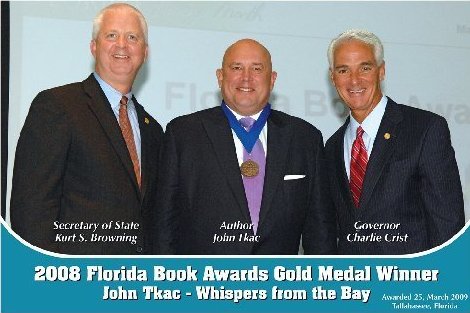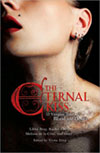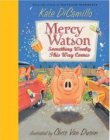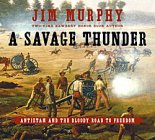Another
Column at MyShelf.Com
|
| Babe To Teens, Past |
|
INTERVIEW WITH JOHN TKAC
Bev: I really enjoyed Whispers from the Bay. Tell us about your life up to now, and your journey to publication. John: I am a born and raised Miami boy. As youngsters, a group of us would fish, snorkel, jump off bridges into the Miami River, and eat pilfered mangos all summer long. After graduating from the University of Notre Dame and getting an M.B.A. from the University of Georgia, I embarked on a career in (youíre going to think this is odd for a young adult author) the retail automobile business. I ran some large, successful dealerships and was blessed with the ability to retire at a reasonably early age. I then began a career as a motivational speaker, consultant, and sales trainer. I had more quiet time with my new endeavors, and my creative writing juices started flowing. For some inexplicable reason, Whispers from the Bay bubbled up in me, and novel writing has now become a passion. Bev: When did you first think about writing a book for teens? John: In 2004 while fishing off Key Largo, Florida, with a few out of state friends, we came upon a pod of dolphins. As we watched them, I mentioned that as a young boy I always saw dolphins in Biscayne Bay and regularly dove in and swam near them. We chatted about the fascinating creatures for the rest of the day. Soon after that event, the thoughts of writing an adventure tale began to stir. I had already left the auto industry, and a pleasant void had entered my life. I mused about my early years in Miami and the first outlines and scribblings began. Bev: What, or who, has been your greatest inspiration for writing? John: Two authors, Mark Twain and Rudyard Kipling, probably inspired me more than any other writers. I tried to give Whispers from the Bay a Tom Sawyer feel, and I wanted the dolphins to be as memorable as some of Kiplingís great characters. I read a wonderful Kipling tale fifty years ago and have always remembered the names of the main characters: the evil cobras Nag and Nagaina, the talkative bird Darzee, and the great Rikki-Tikki-Tavi. I can only hope that readers will remember Nyla, Naar, Naarin, Shanti, Pike, Finn, and the rest of the dolphins. One other book that has influenced me is The Elements of Style by Strunk and White. When I read a book, within a few pages I can tell if the author has a copy of Professor Strunkís work under his pillow. I do. It would be presumptuous of me to compare myself to Kipling or Twain. All I can promise readers is that I will always attempt to climb toward their soaring prose. Bev:
John: I suppose Mike is a compilation of a good many of my boyhood friends and acquaintances. I knew a boy in grade school who stuttered. I donít remember his name, but I do remember him being teased. In Miami, my friends and I were uncomplicated creatures in an uncomplicated time. I portrayed Mike as a smart but introverted young guy in a fairly simple and straightforward world. Of course, Mikeís world becomes far less simple as the story unfolds. Mike promises to keep the dolphinsí secret, and he succeeds in keeping his vow of silence because he is a boy with character. I tried to avoid obvious didactic moments in the story. It is, after all, just a breezy fun read. I have been told by adult readers that there is a message in Mike. It is that having character will stand you in good stead. I hope younger readers catch that message. Bev: And the dolphins? I know that you have been swimming with dolphins since childhood, and probably talking to them. How did you create the dolphin characters? John: My association with dolphins from boyhood has left me with the feeling that they are much more intelligent than humans have ever realized. I researched dolphins for a year because I wanted to portray their behavior in the most scientifically accurate manner. (Except that they telepathically speak English.) During my research, I found many documented instances where dolphins exhibited empathy towards humans. It seemed reasonable to me that the dolphins could have many other human traits and emotions. The dolphins of Whispers from the Bay exhibit love, anger, fear, compassion, loyalty, joy, and they have a very human sense of humor. At every presentation or book talk I have done, at least one young reader asks me, "Do you think dolphins can communicate with us?" I always answer with a twinkle, "Iím not sure. What do you think?" Bev: One of my favorite scenes was fairly early in the book, where Mike cut the net to free the tangled dolphin, Naarin, and rescued him from the hungry sharks. What is your favorite part of the book, and why? John: The shark scene is a great one, and I like Mike catching the sailfish, and the barracuda encounter. My favorite scene, however, is the hurricane. Mike learns of an approaching storm from a dolphin, but he cannot warn the others and tell them how he came by the information. He chooses to say nothing and keep his secret. The consequences are disastrous. This is the pivotal moment in the story. Bev: And, your least favorite, and why? John: Come on. You canít ask an author that question. There are no least favorite parts. However, if I had to pick a least favorite part, I would say—The End. Itís not because the ending is bad. I wanted the story to keep going. The sequel picks up with Mike as a teenager. Bev: John: The Florida Book Awards is sponsored by the University System of Florida and the Florida Humanities Council. Whispers from the Bay won the Gold Medal for Young Adult Literature. And, I was told by the judging committee that Whispers won the Gold in an unprecedented unanimous vote—a wonderful validation for me. The Honorable Governor Charlie Crist presented me with the Gold Medal at a gala event in the State Capitol. It was quite a thrill. Bev: You mentioned to me that chronologically, Whispers from the Bay is actually number three in the series, but that numbers one and two are not yet published. Tell us about that. John: When I wrote Whispers from the Bay, I frantically wrote for about seventy days and produced about 800 pages. I realized that I was writing an epic. I cut 300 pages out of the middle and that became Whispers from the Bay. The 500 pages on either side of Whispers have become the framework for books one, two, four and five. I picked these particular pages because I was most comfortable with them. Now I think books one and two are far more exciting. Bev: Tell us about your writing life. Do you have your plot all figured out before you begin? Do you outline? How much time do you usually devote to writing? John: When Iím not traveling, I write every day. I like to start at 5:00 A.M. and work until about lunchtime. For Whispers and now the others I have an outline that is constantly changing. Within the outline the plot is fairly well established, but not etched in stone. As I said before, it took me seventy days to write the first draft of Whispers, along with the extra pages. I then spent over a year revising and rewriting the manuscript. I did fourteen major rewrites of the story. Why? To get the words right, of course. One other thing, Iím a lousy typist. I wrote Whispers on legal pads with a pencil. Bev: Do you have any advice for your young readers who would like to be writers? John:
Bev: Thank you so much for taking the time to visit with us here at MyShelf.com. I'm looking forward to reading the rest of the series. They almost make me want to abandon Alaska for the sunny beaches of Florida. TIPS FOR WRITING FOR CHILDREN John Tkac gave us some great advice for writing. Check out this presentation for more ideas: New books for teens:
When Katrina spots a guy sleeping in the alley behind her grandmotherís coffee shop, she assumes he is a homeless vagrant. She decides to leave him a cup of coffee, a bag of chocolate-covered coffee beans, and some pastries. But this random act of kindness is about to turn her life upside down. Because this adorable hunk, Malcolm, is really a guardian angel on a break between missions. He wonít leave until he can reward Katrinaís selflessness by fulfilling her greatest wish. Now if only she could decide what that might be...
We love vampire stories. from Bram Stoker to Stephenie Meyer and beyond. For those fresh-blooded fans of paranormal romance or for those who prefer the hunt and hunger stories, these tales have what readers want. This collection comes from some of the hottest, most popular YA writers, including Melissa de la Cruz, Cecil Castellucci, Kelley Armstrong, Holly Black, Libba Bray, Cassandra Clare, and Lili St. Crow.
New books for younger kids:
Did you ever consider taking a pig to the movies? Mr. and Mrs. Watson think the title of the film, When Pigs Fly, is inspirational. and their beloved Mercy, who is inspired by the fact that the drive-in proudly serves real butter on its Bottomless Bucket of popcorn, lifts her snout and becomes a pig on a mission and it's off to the movies and searching for that true butter smell.
Growing up in the shadow of his football star brother, Chris, Newt Newman has never felt very special. But then, when Chris is knocked unconscious, Newtís best friends decide that taking him out for Halloween is the best way to cheer him up. Using some of Chrisís old, oversized clothes, Newt creates his best costume ever—Captain Nobody! Newt feels so great in his new getup that he keeps wearing.. The new Newt becomes a hero in a string of adventures that include foiling a robbery and saving a planeload of passengers. But will Captain Nobody be able to save the one person he cares about most?
In September 1862, two great armies faced off across Antietam Creek, near Sharpsburg, Maryland, and the fate of the United States and millions of slaves were at stake. From behind-the-scenes conversations to the action on the front lines, writer Jim Murphy provides an in-depth look at the battle that prompted Abraham Lincoln to issue the Emancipation Proclamation and changed America forever. There are photographs, maps, and first-person accounts to sweep young readers into the chaos and excitement of battle. Real history at it's best.
Here is the best lost homework excuse ever! What do you do when your teacher assigns you 10 pages of homework, a raptor swoops down and grabs you, and you suddenly find yourself all alone in the jungle about to be swallowed by a huge snake? When you're Digby, the solution to every problem is in your backpack. Fun reading, and great illustrations. |
|
2009 Past Columns |
||||||||||
 John Tkac (Pronounced Tack) is the award
winning author of an exciting story about a
boy and his relationship with dolphins, called
Whispers From the Bay (
John Tkac (Pronounced Tack) is the award
winning author of an exciting story about a
boy and his relationship with dolphins, called
Whispers From the Bay (
 Tell us about the recent award you received
for Whispers from the Bay.
Tell us about the recent award you received
for Whispers from the Bay.




